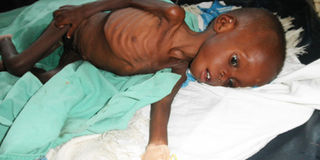Malnutrition in children on the rise in Iganga

A severely malnourished child lies on a bed in Iganga hospital: With more children being admitted to hospitals because of malnutrition, it has become a cause for concern.
What you need to know:
A trip to a hospital in Iganga reveals the extent of the problem of child malnutrition in this part of the country. As Yazid Yolisigira finds out
It was one Thursday morning when I paid a courtesy call to Iganga hospital. On reaching the paediatric ward, I was disturbed by the cry of a child that was coming from the extreme corner of the ward.
As I approached the bed from where I was heard the sound, there was neither single parent nor guardian around the crying child.
But as I continued looking around the bed, the cry resumed. It was then that I was able to see a little child lying covered in a piece of cloth.
I called out to one of the medical personnel who was attending to another child to come and find out what was wrong.
On removing the cloth from the child, I was shocked. I could not believe how small the child was. It had deformed body parts, very tiny legs and white protruding eyes. I asked the nurse what the child was suffering from. She told me that it was malnutrition, a problem caused by poor feeding.
The mother of the child, Cissy Musubika, returned several minutes later. She explained that she was outside lining up for free food which was being provided by a good Samaritan.
She said her child was one year-and-eight months and had started to fall sick two months after birth. “The child was crying a lot and neighbours advised me to take her to the health centre saying that she was suffering from malaria. I took her to Nawandala Health Centre III where she got some treatment. She used to have convulsions,” she said.
“After six months she started losing weight. I was working at a nearby school as a cook and I used to feed her on porridge but she was not gaining any weight,” narrated Musubika, a resident of Nawandala village in Iganga district.
A mother of four children, she was referred to Iganga hospital but her husband, Fred Mutyatyama, a charcoal seller, failed to provide her with transport of about Shs5,000 to visit the government health facility.
The father of the child strongly believed that the condition was as a result of witchcraft. One day, he returned from work with some herbs which Musubika has been applying on the child until two weeks ago when the child had difficulty breathing, which prompted him to bring them to hospital.
The in-charge of the ward, Ms Annet Namusobya said the child is very malnourished and blames parents for delaying to bring her for treatment.
Ms Namusobya added that cases of malnutrition are on the rise, disclosing that from June this year, they have registered 59 cases. Malnutrition is the second leading disease in the ward after malaria.
“In June, we admitted 28 malnourished children and 31 so far in July. Out of these, two have died. Those who died were so malnourished,” she says.
“Their parents delayed to take them to health centres thinking that it was simple fever. By the time we received them the condition had deteriorated and they died,” she revealed.
According to her, she expects this child would get better given the improvement she has made over the past week.However Musubika is not the only one nursing a malnourished child.
Next to her bed is Madina Nairuba, from Nakigo sub-county, whose child had stayed in the ward for three weeks. Her child had started eating some food unlike in the days when she was admitted.
The majority of them claim that insufficient food caused by the dry spell is the cause. Outside the ward, they always line up at around noon to get free food which includes posho, beans and avocado from a good Samaritan, only identified as an American, who is called Nil. He came to the hospital for an internship.
As he entered the ward to carry out his research, he was shocked at the sight of these children. He pledged to the hospital administration to assist them with some food, which he has done now for about two months, according to one of the hospital staff. The food is purposely for supplementing the diet of the malnourished children.
Dr Siraji Kizito, a medical specialist in the hospital said that malnutrition is caused by poor feeding. There are two types of malnutrition: kwashiorkor and marasmus.
The symptoms of kwashiorkor are that the body gets swollen especially the cheeks, abdomen and the legs while with marasmus, the child loses weight, becomes thin and anaemic.
Dr Kizito said malnutrition is mostly caused by lack of proteins in the body. “Much as the body requires all the five food values: vitamins, carbohydrates, mineral salts and proteins, the last one is the main component for a better growth,” says the doctor.
Another cause is the presence of intestinal worms in the body which feed on the little food that is available hence leaving one malnourished.
As a solution, the medical specialist said children should be fed mostly on food containing proteins like milk and beans. This is in addition to others which have other food values. Children should also be dewormed routinely until there are five years old.
They should also be taken to health centres quickly once they fall sick other than keeping them at home.




